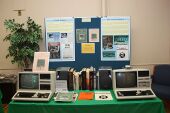
My exhibit for VCF East 10 (2015) featured my original TRS-80 Model 4 from 1984, with a bunch of enhancements (some vintage, some modern). I purchased the system from a VAR (Value Added Reseller) with 1/2 height, double-sided drives (Teac FD-55B), 128KB of RAM and an RS-232 serial board. I hated the flickering, white phosphor CRT, and immediately replaced it with a longer decay amber phosphor CRT from Langley-St. Clair. This in turn caused a problem during power-off. At power-off, the display shrinks rapidly to a bright dot in the middle of the screen. On the original CRT, that wasn't a problem. On the amber CRT, the dot quickly burned a short line segment in the middle of the CRT. To prevent additional screen burn, I installed a second power switch on the left side of the machine to cut the 12VDC power to the monitor board. By cutting monitor power first, the display shrank to a much more reasonable vertical line, and no further damage occurred.
Back in the day, I also purchased an Orchestra-90 synthesizer from Radio Shack. The hardware interface itself is very simple: port addressing, a pair of latches and 4 resistor packs for a DAC (Digital to Analog Converter). The heavy lifting is done in software, with sample tables and some rudimentary waveform control. The output is in stereo, with up to 5 voices on the Model 4. A large user community grew up around a Compuserve SIG which offered hundreds of song files for download.
In recent months, I replaced the 200ns RAM chips with 100ns chips, and disabled the built-in wait state to make my non-Gate Array Model 4 run as fast as the later Gate Array versions. See section 4c on this document. I also ordered and built kit "B" of the FreHD hard drive emulator from Ian Mavric in Australia. The FreHD emulator uses SD cards to store hard drive image files which can be accessed by the Model 4 (and others) as emulated hard drives. I also burned an EPROM with an image from Ian which replaces the ROM-C in the Model 4, and allows it to boot directly from the FreHD, with a menu to select the desired drive image. The drive images available are LDOS 5.1, LSDOS 6.3.1, NewDOS80 V2.5 and Montezuma Micro CP/M 2.2.
Another potential problem arose with the combination of the Orchestra-90 and the FreHD. The Model 4 only has a single external connector for the I/O expansion bus. I could have manufactured a cable to connect both pieces of hardware, but I discovered an interesting feature of my Model 4. On the motherboard, immediately above the I/O connector is a silk-screened outline of a a double-row, 0.1" spaced stake pin connector. The pads correspond directly to the 50-pin card-edge connector, so I cleaned out the holes and soldered in a double-row connector, attached a ribbon cable and led it out through the existing cutout for the card-edge connector. I was then able to connect both the Orchestra-90 (to the card-edge connector) and the FreHD (to the new ribbon cable) at the same time.
Finally, I transplanted a Tandy 26-1126 HiRes Graphics board from a Model 4P into the Model 4. The HiRes board can display up to 640x240 graphics, and plugs into a connector on the motherboard. There isn't a large selection of software available which can use the HiRes board, but there are a batch of games, BASIC support, CAD and drawing programs available.
Shortly before VCF East 10, I talked to Ian Mavric about his new Model 4 HiRes graphics board, based on the Micro-Labs Grafyx Solution board. It also will display 640x240, but is said to run 25% faster than Tandy's HiRes board. Ian sent me a pair of boards for my exhibit, one of which was installed in a Model 4D on loan from another M.A.R.C.H. member. He also included another FreHD in a custom case. I ended up running CAD demos and HiRes games on both systems throughout the weekend. Ian's hardware performed flawlessly. I was able to show both Ian's board and the original Grafyx Solution board, outside of the machine.